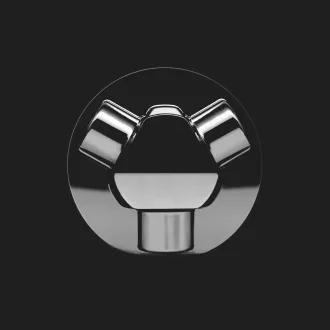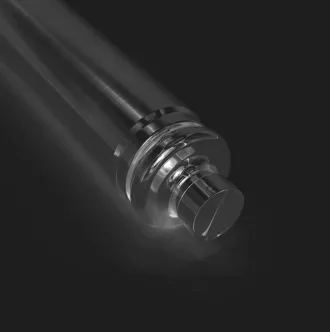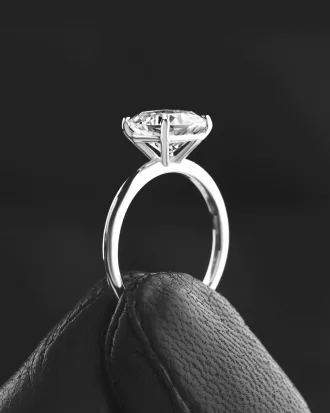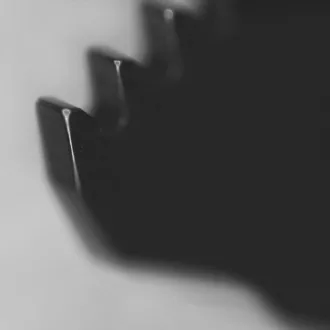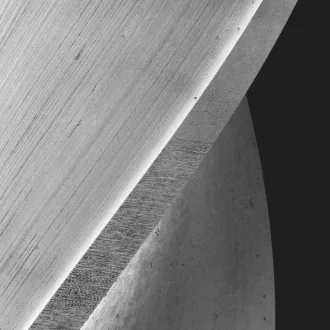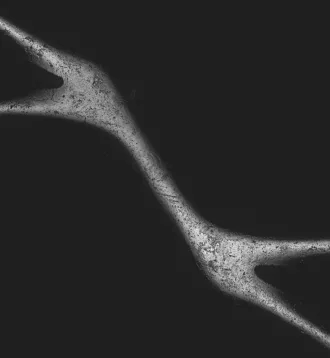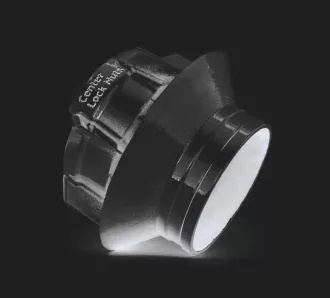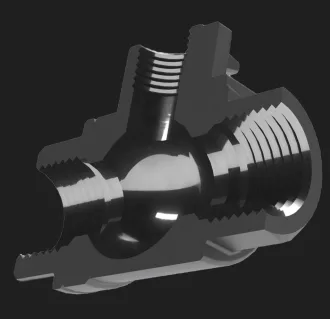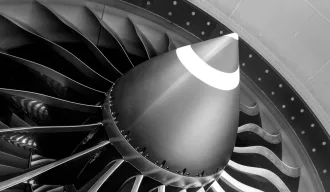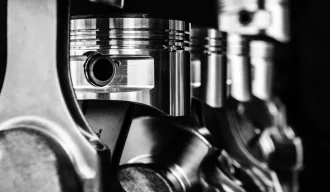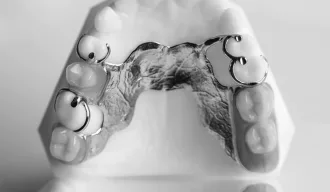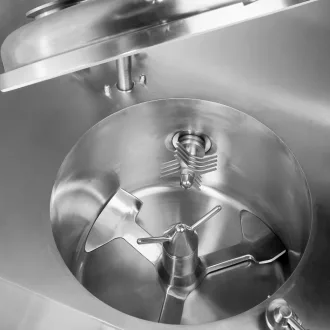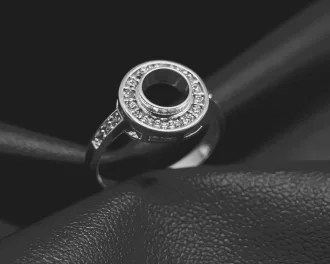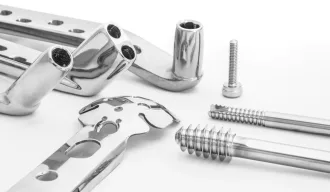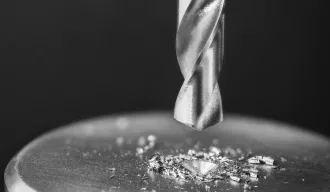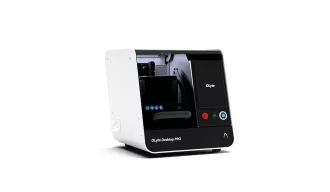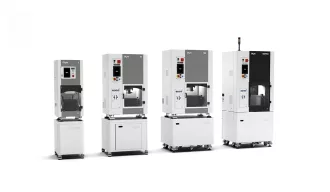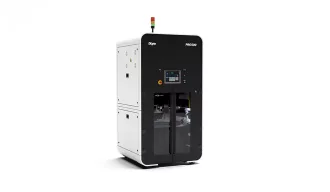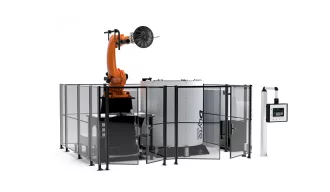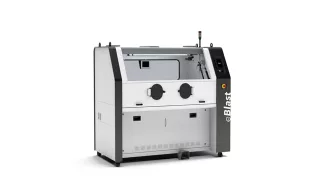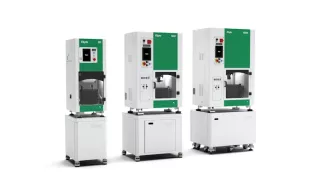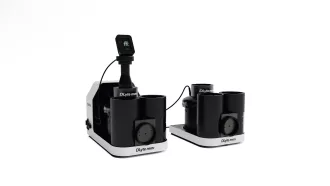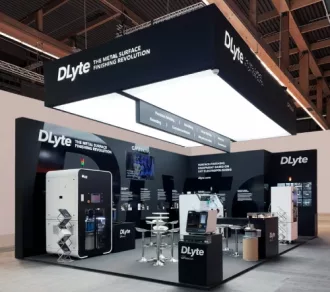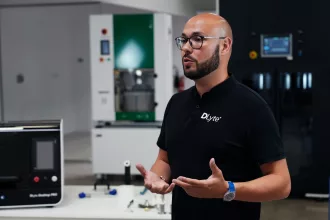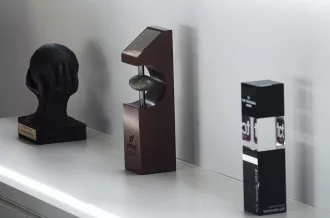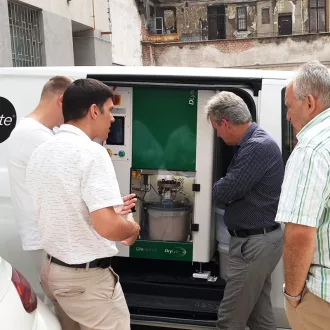01.
Negative skewness (Rsk)
Dry electropolishing is often considered to be a good process for achieving negative skewness (Rsk) because it is a highly precise and controllable process that can produce a very smooth, uniform surface.
A smooth, uniform surface can improve the internal flow of tubes and valves by reducing the amount of friction and turbulence that occurs as fluids or gases flow through the tube or valve.
In dry electropolishing, an electrical current is used to remove a very thin, uniform layer of material from the surface of a workpiece. This can result in a surface with a high degree of surface smoothness and uniformity, which can improve the internal flow of tubes and valves.
Negative skewness (Rsk) refers to the degree of unevenness or asymmetry in the surface of a workpiece. A workpiece with negative skewness has a surface that is more uneven or asymmetrical than a workpiece with positive skewness. Dry electropolishing can be used to achieve negative skewness by selectively removing material from the surface of the workpiece, creating an uneven or asymmetrical distribution of roughness, with more peaks (asperities) than valleys. This type of surface can be important in metal mechanical parts for several reasons:
Improved fatigue resistance: A surface with negative skewness can improve the fatigue resistance of metal parts by providing additional contact area between the part and other surfaces. This can help to distribute loads more evenly and reduce the risk of fatigue failure.
Enhanced wear resistance: A surface with negative skewness can improve the wear resistance of metal parts by providing additional points of contact between the part and other surfaces. This can help to distribute wear more evenly and extend the service life of the part.
Improved lubrication: A surface with negative skewness can improve the lubrication of metal parts by providing additional points of contact between the part and the lubricant. This can help to reduce friction and wear, and extend the service life of the part.
Overall, the combination of these benefits can make a surface with negative skewness an important feature in metal mechanical parts, particularly those that are subjected to high loads, wear, and friction during use.
02.
Corrosion resistance
Corrosion resistance is important in metal parts for a number of reasons. First, corrosion can reduce the strength and integrity of a metal part, making it more likely to fail or break. This can be particularly problematic in critical components or structures that are subject to high loads or stresses.
In addition, corrosion can also reduce the aesthetic appeal of a metal part, which can be important in certain applications. For example, a corroded metal part may not be visually appealing in a consumer product, and could lead to customer dissatisfaction.
Furthermore, corrosion can also increase the maintenance and repair costs associated with a metal part. This is because corrosion can require the part to be cleaned, repaired, or replaced more frequently, which can be time-consuming and costly.
Overall, improving the corrosion resistance of a metal part can help to extend its lifespan, reduce the risk of failure, improve its appearance, and reduce maintenance and repair costs.
03.
Drastic lifespan increase
Dry electropolishing is often considered to be the best method for increasing the lifespan of a metal part due to the improved surface that it produces. An electrical current is used to remove a very thin, uniform layer of material from the surface of a workpiece. This can result in a surface with a high degree of surface smoothness and uniformity. A smoother surface finish can reduce the amount of stress concentration at the surface of the part, which can lead to reduced fatigue and wear. This is because smooth surfaces have fewer imperfections and irregularities that can act as stress risers, which are areas of the material that are more susceptible to failure due to the concentration of stress.
In addition, a smoother surface finish can also reduce the amount of surface friction and wear on the part. This is because rough surfaces tend to have more surface asperities, or small protuberances, that can cause increased friction and wear as the part moves against other surfaces. A smooth surface, on the other hand, will have fewer asperities and thus will experience less friction and wear.
A smooth, uniform surface can improve also the ability of the cutting tool to dissipate heat, which can help to prevent overheating and also extends the lifespan of the tool.
Finally, a smooth surface finish can also improve the corrosion resistance of a metal part. This is because rough surfaces tend to have more surface area exposed to the environment, which can increase the likelihood of corrosion. Smooth surfaces, on the other hand, have less surface area exposed and are therefore less likely to corrode.
Overall, the improved surface quality of a metal part can lead to reduced stress concentration, reduced friction and wear, and improved corrosion resistance, all of which can contribute to increased lifespan.
04.
Geometry preservation
Preserving geometry with high accuracy, tight tolerances, and preserved edges is important in precision metal parts for a number of reasons.
First, high accuracy and tight tolerances are important in order to ensure that the part functions as intended and meets the required specifications. This is particularly important in applications where the part must fit or interact with other components in a precise manner. For example, a precision metal part may be required to fit within a specific tolerance range in order to function properly, and deviations from this tolerance range could lead to problems.
Second, preserving edges is important in order to maintain the integrity of the part. This is because the edges of a part are often subject to high stress concentrations, and preserving the sharpness of these edges can help to reduce the risk of failure due to fatigue or wear. In addition, preserved edges can also be important for the aesthetic appeal of the part, as well as for certain functional requirements.
Overall, preserving geometry with high accuracy, tight tolerances, and preserved edges is important in precision metal parts in order to ensure that the part functions properly, maintains its integrity, and meets the required specifications.
05.
Reflective and bright effect
This process can achieve a highly reflective and bright appearance on metals because it is able to remove a very thin layer of material from the surface of the workpiece, which can result in a smooth, mirror-like finish.
One reason why dry electropolishing may be particularly effective at achieving a reflective and bright appearance is that it uses an electrical current to remove material from the surface of the workpiece. This can be more precise and controlled compared to other methods, such as mechanical grinding or sanding, which can remove more material and may not be as precise.
In addition, dry electropolishing can also remove surface impurities, such as oxides or contaminants, which can contribute to a brighter and more reflective finish. This is because these impurities can absorb light and reduce the reflectivity of the surface, and their removal can help to improve the overall appearance of the workpiece.
06.
For complex and fragile parts
Dry electropolishing is a good method for surface finishing fragile and complex parts that cannot be impinged because it is an electrochemical process that does involve very low physical contact with the workpiece. This means that it can be used to finish delicate or fragile parts without the risk of damaging them through mechanical means.
In addition, dry electropolishing is also well-suited for complex parts because it can be precisely controlled to remove a very thin layer of material from the surface of the workpiece. This can be particularly useful for parts that have intricate features or tight tolerances, as it allows for precise finishing without the risk of altering the geometry of the part.
Finally, dry electropolishing is also a relatively fast process, which can be beneficial when working with complex parts that may have many intricate features or tight tolerances. This can help to reduce the overall time required to finish the part, which can be important for certain applications.
Overall, the non-mechanical nature, precision, and speed of dry electropolishing make it a good method for surface finishing fragile and complex parts that cannot be impinged.
07.
Reliability and repeatability
Dry electropolishing is a method for surface finishing metal parts with high reliability and repeatability for several reasons.
First, dry electropolishing is a highly controllable process, which allows for precise and consistent material removal from the surface of the workpiece. This can be particularly important for parts that require tight tolerances or have specific surface finish requirements.
Second, dry electropolishing is a relatively fast process, which can help to reduce the overall time required to finish the part. This can be important for certain applications where speed is a key concern.
Third, dry electropolishing is also a relatively simple process that does not require a lot of setup or complex equipment. This can help to reduce the risk of errors or variability in the finishing process, and can contribute to the overall reliability and repeatability of the process.
Finally, dry electropolishing is also a electrochemical non-mechanical process that does involve very low physical contact with the workpiece. This can be beneficial for delicate parts, as it can help to reduce the risk of damage or alteration to the part during the finishing process.
Overall, the controllability, speed, simplicity, and non-mechanical nature of dry electropolishing make it a reliable and repeatable method for surface finishing metal parts.
08.
Remove scratches and milling lines
Dry electropolishing is generally considered to be an effective method for removing scratches and milling lines from metal pieces because it is a very precise and controllable process. In dry electropolishing, an electrical current is used to remove material from the surface of a workpiece, and the rate at which material is removed can be precisely controlled. This allows the operator to remove only a very thin layer of material, which can be beneficial for removing scratches and milling lines without significantly altering the overall shape or size of the workpiece.
In contrast, abrasive finishing methods, such as sanding or grinding, can be less precise and may remove a thicker layer of material, which can be more difficult to control. This can make it more challenging to remove scratches and milling lines without altering the overall shape or size of the workpiece.
Liquid electropolishing can also be effective for removing scratches and milling lines, but it typically involves the use of chemical solutions, which can be hazardous to workers and can generate hazardous waste products. Dry electropolishing does not involve the use of any chemicals and does not produce any hazardous waste products, which can make it a safer and more environmentally friendly option.
09.
Isotropic surfaces
Dry electropolishing is considered to be the best process for achieving an isotropic surface because it is a highly precise and controllable process. An isotropic surface is a surface that has the same properties in all directions, which can be difficult to achieve with other surface finishing techniques.
In dry electropolishing, an electrical current is used to remove material from the surface of a workpiece in a very controlled and precise manner. This allows the operator to remove a very thin, uniform layer of material from the surface, which can result in an isotropic surface with a high degree of surface smoothness and uniformity.
In contrast, other surface finishing techniques, such as abrasive finishing or liquid electropolishing, may not be as precise and may result in a surface that is not isotropic. For example, abrasive finishing methods, such as sanding or grinding, can produce a surface that is rougher and less uniform, and liquid electropolishing may result in a surface that is not isotropic due to the chemical reactions that occur during the process.
Overall, dry electropolishing is a highly precise and controllable process that is well-suited for producing isotropic surfaces with a high degree of surface smoothness and uniformity.
10.
Pathogen resistance
Dry electropolishing can create pathogen-resistant surfaces because it is a highly precise and controllable process that can produce a very smooth, uniform surface. A smooth, uniform surface is less likely to harbor pathogens, such as bacteria and viruses, than a rough or uneven surface.
In dry electropolishing, an electrical current is used to remove a very thin, uniform layer of material from the surface of a workpiece. This can result in a surface with a high degree of surface smoothness and uniformity, which is less likely to harbor pathogens than a rougher or more uneven surface.
Additionally, dry electropolishing can remove any existing contaminants or pathogens from the surface of a workpiece, further reducing the risk of pathogen contamination. This can be particularly useful for applications where cleanliness and pathogen control are important, such as in the medical or food processing industries.
Overall, dry electropolishing is a highly effective process for creating pathogen-resistant surfaces due to its ability to produce a smooth, uniform surface that is less likely to harbor pathogens.
11.
Decorative finish
Dry electropolishing can be used to achieve a decorative finish on metal surfaces because it is a highly precise and controllable process that can produce a very smooth, uniform surface. A smooth, uniform surface is often desired for decorative applications because it can produce a high-quality, visually appealing finish.
In dry electropolishing, an electrical current is used to remove a very thin, uniform layer of material from the surface of a workpiece. This can result in a surface with a high degree of surface smoothness and uniformity, which is highly desirable for decorative applications.
Additionally, dry electropolishing can be used to produce a wide range of finishes, from a highly polished, mirror-like finish to a more matte or satin finish. This flexibility allows designers and fabricators to achieve a wide range of decorative effects with dry electropolishing.
Overall, dry electropolishing is an effective process for achieving a decorative finish on metal surfaces due to its ability to produce a smooth, uniform surface with a wide range of finishes.
12.
Cleanability improvement
Dry electropolishing is often considered to be the best surface finishing process for improving the cleanability of a part because it can produce a very smooth, uniform surface that is less likely to harbor contaminants or pathogens. A smooth, uniform surface is easier to clean and disinfect than a rough or uneven surface, and it is less likely to harbor contaminants or pathogens that can cause illness or infection.
In dry electropolishing, an electrical current is used to remove a very thin, uniform layer of material from the surface of a workpiece. This can result in a surface with a high degree of surface smoothness and uniformity, which is highly desirable for cleanability.
Additionally, dry electropolishing can remove any existing contaminants or pathogens from the surface of a workpiece, further improving its cleanability. This can be particularly useful for applications where cleanliness is important, such as in the medical or food processing industries.
13.
Remove microburrs without rounding edges
Dry electropolishing is often considered to be a good method for removing micro burrs without rounding edges because it is a very precise and controllable process that can remove a very thin, uniform layer of material from the surface of a workpiece. In contrast, other surface finishing methods, such as abrasive finishing or liquid electropolishing, may be less precise and may remove a thicker layer of material, which can be more difficult to control and can result in rounded edges.
In dry electropolishing, the rate at which material is removed from the surface of a workpiece can be precisely controlled, which allows the operator to remove only a very thin layer of material. This can be beneficial for removing micro burrs without rounding edges, as it allows the operator to remove only the burrs without altering the overall shape or size of the workpiece.
14.
Controlled rounding of cutting edges
Dry electropolishing is often considered to be the best method for rounding the cutting edges of cutting tools in a very controlled way because it is a highly precise and controllable process that can remove a very thin, uniform layer of material from the surface of a workpiece. In contrast, other surface finishing methods, such as abrasive finishing or liquid electropolishing, may be less precise and may remove a thicker layer of material, which can be more difficult to control and can result in uneven or irregular rounding of the cutting edges.
In dry electropolishing, the rate at which material is removed from the surface of a workpiece can be precisely controlled, which allows the operator to remove only a very thin layer of material. This can be beneficial for rounding the cutting edges of cutting tools in a very controlled way, as it allows the operator to achieve a precise level of rounding without altering the overall shape or size of the tool.
Overall, dry electropolishing is a highly precise and controllable process that is well-suited for rounding the cutting edges of cutting tools in a very controlled way due to its ability to remove a very thin, uniform layer of material from the surface of a workpiece.
15.
Aesthetic improvement
Dry electropolishing can improve the visual aspect of cutting tools because it is a highly precise and controllable process that can produce a very smooth, uniform surface. A smooth, uniform surface is often desired for cutting tools because it can produce a high-quality, visually appealing finish.
In dry electropolishing, an electrical current is used to remove a very thin, uniform layer of material from the surface of a workpiece. This can result in a surface with a high degree of surface smoothness and uniformity, which can improve the overall appearance of the cutting tool.
Additionally, dry electropolishing can be used to produce a wide range of finishes, from a highly polished, mirror-like finish to a more matte or satin finish. This flexibility allows designers and fabricators to achieve a wide range of decorative effects with dry electropolishing, which can further improve the visual aspect of cutting tools.
Overall, dry electropolishing is an effective process for improving the visual aspect of cutting tools due to its ability to produce a smooth, uniform surface with a wide range of finishes.
16.
Prepare tool surface for coating process
Dry electropolishing is often preferred as a method to prepare the surface of cutting tools for coating processes because it is a highly precise and controllable process that can produce a very smooth, uniform surface. A smooth, uniform surface is often desired for coating processes because it can improve the adhesion and durability of the coating.
In dry electropolishing, an electrical current is used to remove a very thin, uniform layer of material from the surface of a workpiece. This can result in a surface with a high degree of surface smoothness and uniformity, which is highly desirable for coating processes.
Additionally, dry electropolishing can remove any existing contaminants or imperfections from the surface of a workpiece, further improving its suitability for coating processes. This can be particularly important for applications where the coating is required to perform at a high level, such as in high-wear or high-stress environments.
Overall, dry electropolishing is an effective process for preparing the surface of cutting tools for coating processes due to its ability to produce a smooth, uniform surface that is well-suited for coating applications.
17.
Increased machining speed
Dry electropolishing can improve the surface of cutting tools and increase machining speed due to the improved surface finish that it produces. In dry electropolishing, an electrical current is used to remove a very thin, uniform layer of material from the surface of a workpiece. This can result in a surface with a high degree of surface smoothness and uniformity, which can improve the performance and lifespan of cutting tools.
Improved surface smoothness and uniformity can lead to a number of benefits for cutting tools, including:
- Reduced friction: A smooth, uniform surface can reduce the amount of friction that occurs between the cutting tool and the workpiece, which can increase machining speed.
- Improved wear resistance: A smooth, uniform surface is less likely to wear or deform over time, which can help to extend the life of the cutting tool and increase machining speed.
- Improved heat dissipation: A smooth, uniform surface can improve the ability of the cutting tool to dissipate heat, which can help to prevent overheating and extend its life, allowing for increased machining speed.
Overall, dry electropolishing is an effective process for improving the surface of cutting tools and increasing machining speed due to its ability to produce a smooth, uniform surface that can improve the performance and lifespan of the tool.
18.
Inert, clean and avoids bio-film formation
Dry electropolishing is often considered to be a good process for achieving an inert, clean surface that avoids bio-film formation because it is a highly precise and controllable process that can produce a very smooth, uniform surface. A smooth, uniform surface is less likely to harbor contaminants or pathogens, which can reduce the risk of bio-film formation.
In dry electropolishing, an electrical current is used to remove a very thin, uniform layer of material from the surface of a workpiece. This can result in a surface with a high degree of surface smoothness and uniformity, which is less likely to harbor contaminants or pathogens.
Additionally, dry electropolishing can remove any existing contaminants or pathogens from the surface of a workpiece, further reducing the risk of bio-film formation. This can be particularly useful for applications where cleanliness and pathogen control are important, such as in the medical or food processing industries.
Overall, dry electropolishing is an effective process for achieving an inert, clean surface that avoids bio-film formation due to its ability to produce a smooth, uniform surface that is less likely to harbor contaminants or pathogens.
19.
Performs inner and outer polishing
Dry electropolishing is often considered to be a good process for achieving internal and external polishing in the same process with the use of an internal cathode because it is a highly precise and controllable process that can produce a very smooth, uniform surface. In dry electropolishing, an electrical current is used to remove a very thin, uniform layer of material from the surface of a workpiece.
To achieve both internal and external polishing in the same process with the use of an internal cathode, the workpiece is typically placed in a special fixture that holds the workpiece in place and allows access to both the internal and external surfaces. An internal cathode is then inserted into the workpiece, and an electrical current is passed through the workpiece, causing material to be removed from both the internal and external surfaces.
This process can be highly effective for achieving both internal and external polishing in the same process, as it allows the operator to produce a smooth, uniform surface on both the internal and external surfaces of the workpiece without the need for multiple processes or fixtures.
Overall, dry electropolishing is a good process for achieving internal and external polishing in the same process with the use of an internal cathode due to its precision and ability to produce a smooth, uniform surface.
20.
Short processing time in a compact design
Dry electropolishing improves the processing times of existing surface finishing processes up to 10 times.
It replaces several finishing steps, including the corrosion resistance improvement in just one compact equipment, thus reducing the space required for surface finishing. Furthermore, there is no need to use an isolated plant to process parts or water recycling system, with the consequent reduction of required space in the factory.
Finally, it has a high capacity per cycle compared to abrasive finishing equipment because the process is performed through ion exchange, which does not require high mechanical energy or abrasion, allowing for close packing of the pieces in the fixtures.
21.
No devices to manage sewage and sludge
Dry electropolishing does not require peripherals for wastewater and sludge management because it uses a non-fluid electrolyte in the form of beads, instead of a liquid solution. This means that there is no need for special storage or disposal of hazardous chemicals, reducing the environmental impact of the process.
Both liquid electropolishing and vibratory finishing equipment require peripheral devices. Abrasive finishing uses water and compounds and requires a water recycling systems and sludge treatment plants. Liquid electropolishing also requires a partial replacement of the liquids and treatment of the sludges to operate.
22.
High profitability and short payback time
There are several factors that contribute to reach a higher profitability and short payback time associated with dry electropolishing.
Firstly, dry electropolishing is a non-abrasive process, which means that it is less destructive to the metal surface, reducing the need for frequent replacement of consumables such as grinding and polishing media. This results in a lower cost of ownership and higher productivity compared to abrasive finishing processes.
Additionally, dry electropolishing eliminates the need for wastewater and sludge management peripherals, as it uses a solid electrolyte instead of a liquid one, reducing the costs associated with the disposal of hazardous chemicals. Moreover, the process is highly efficient and produces a consistent, high-quality surface finish, allowing for faster processing times, reduced cycle times and lower operating costs. All of these factors contribute to higher profitability and short payback time of dry electropolishing.
23.
Environmentally friendly
Dry electropolishing is considered an environmentally friendly surface finishing process due to the various benefits it has over other processes.
Firstly, the process requires minimal water consumption in comparison to traditional abrasive and liquid electropolishing processes.
Additionally, the process does not use any hazardous chemicals, meaning that there is no risk of contamination to the environment.
Moreover, no sludges or liquids are produced as a result of the process, which eliminates the need for a specialized waste management and disposal, further reducing the environmental impact.
24.
Protects workers' health
DLyte improves over traditional polishing methods such as manual surface finishing, liquid electropolishing, and abrasive vibratory finishing in terms of worker safety.
Dlyte is a dry, non-toxic, silent and dust-free process that utilizes electrochemistry to smooth and finish surfaces, eliminating the use of liquid or chemical-based solutions that may pose a risk to workers if handled improperly. As a result, the process minimizes the risk of hazardous exposure to workers and reduces the risk of musculoskeletal disorders (MSDs), hearing loss, respiratory and eye irritation compared to traditional methods.
There is research on the potential hazards to workers from repetitive postural movements, and dust emissions generated during manual buffing of parts.
Repetitive postural movements can lead to MSDs, which are injuries or disorders that affect the muscles, nerves, tendons, ligaments, and other soft tissues.
The dust generated during the manual buffing process can contain a variety of substances, including metal particles, ceramic, and resin particles, depending on the materials being worked on.
Exposure to dust can potentially lead to a range of health effects, including respiratory problems, and eye or skin irritation. In addition, some of the substances present in the dust, such as metals, may be toxic if inhaled or ingested in large amounts.
The exposure to hazardous noise is a common occupational risk and repeated overexposure to noise can cause permanent hearing loss, tinnitus, and difficulty understanding speech.
